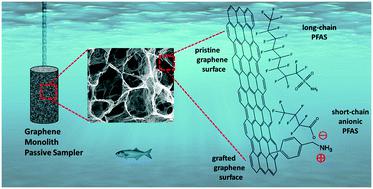当前位置:
X-MOL 学术
›
Environ. Sci.: Nano
›
论文详情
Our official English website, www.x-mol.net, welcomes your feedback! (Note: you will need to create a separate account there.)
A graphene-based hydrogel monolith with tailored surface chemistry for PFAS passive sampling
Environmental Science: Nano ( IF 7.3 ) Pub Date : 2021-08-10 , DOI: 10.1039/d1en00517k Jitka Becanova 1 , Zachary S S L Saleeba 2 , Aidan Stone 2 , Anna R Robuck 1 , Robert H Hurt 2 , Rainer Lohmann 1
Environmental Science: Nano ( IF 7.3 ) Pub Date : 2021-08-10 , DOI: 10.1039/d1en00517k Jitka Becanova 1 , Zachary S S L Saleeba 2 , Aidan Stone 2 , Anna R Robuck 1 , Robert H Hurt 2 , Rainer Lohmann 1
Affiliation

|
Aquatic contamination by per- and polyfluorinated alkyl substances (PFAS) has attracted global attention due to their environmental and health concerns. Current health advisories and surface water regulatory limits require PFAS detection in the parts per trillion (ppt) range. One way to achieve those low detection limits is to use a reliable passive sampling-based monitoring tool for PFAS, as exists for numerous nonpolar persistent organic pollutants. Here we introduce a new graphene-based hydrogel monolith and describe its synthesis, chemical functionalization, property characterization, and testing as a PFAS equilibrium passive sampler. The graphene monoliths were self-assembled by hydrothermal treatment from graphene oxide (GO) aqueous dispersions to produce free standing cylinders of ∼563 mm3 volume consisting of 4 wt% thin-walled porous graphene and ∼96 wt% water. The uptake of 23 PFAS was measured on the as-produced monoliths, and equilibrium partition coefficients (KSW), were derived for longer chain (C ≥ 8) perfluoroalkyl acids (PFAA) and neutral precursors such as sulfonamides (log KSW range 1.9–3.6). To increase the KSW for shorter chain PFAA, the monoliths were chemically modified by a new diazonium-based grafting reaction that introduces positive surface charge without damage to the graphenic backbone. Introduction of benzylamine moieties through the diazonium intermediate switches zeta potential at pH 7 from −45 mV (as-produced graphene) to +5 mV. This modification increased the sorption of short and middle chain PFAA by ten-fold (e.g. log KSW for PFBA increased from 1.3 to 2.2), thereby improving the functionality of the passive sampler device for a wider range of PFAS. Field deployments demonstrated that the graphene monoliths were capable of detecting key PFAS in the Delaware River.
中文翻译:

用于 PFAS 被动采样的具有定制表面化学的石墨烯基水凝胶整体
全氟和多氟烷基物质 (PFAS) 的水生污染因其环境和健康问题而引起了全球的关注。当前的健康咨询和地表水监管限制要求在万亿分之几 (ppt) 范围内检测 PFAS。实现这些低检测限的一种方法是使用可靠的基于被动采样的 PFAS 监测工具,就像许多非极性持久性有机污染物一样。在这里,我们介绍了一种新的基于石墨烯的水凝胶整体,并描述了它的合成、化学功能化、性质表征和作为 PFAS 平衡被动采样器的测试。石墨烯整体通过水热处理从氧化石墨烯(GO)水分散体自组装以产生~563 mm 3的独立圆柱体体积由4 wt%的薄壁多孔石墨烯和~96 wt%的水组成。在所生产的整体上测量了 23 种 PFAS 的吸收,并推导出长链 (C ≥ 8) 全氟烷基酸 (PFAA) 和中性前体如磺胺类 (log K SW范围 1.9 ) 的平衡分配系数 ( K SW ) –3.6)。增加K SW对于较短链的 PFAA,整体材料通过一种新的基于重氮的接枝反应进行化学改性,该反应引入正表面电荷而不会损坏石墨主链。通过重氮中间体引入苄胺部分可将 pH 7 时的 zeta 电位从 -45 mV(原样石墨烯)切换到 +5 mV。这种修改将短链和中链 PFAA 的吸附增加了 10 倍(例如,PFBA 的log K SW从 1.3 增加到 2.2),从而改进了被动采样器装置的功能,适用于更广泛的 PFAS。现场部署表明,石墨烯单体能够检测特拉华河中的关键 PFAS。
更新日期:2021-08-25
中文翻译:

用于 PFAS 被动采样的具有定制表面化学的石墨烯基水凝胶整体
全氟和多氟烷基物质 (PFAS) 的水生污染因其环境和健康问题而引起了全球的关注。当前的健康咨询和地表水监管限制要求在万亿分之几 (ppt) 范围内检测 PFAS。实现这些低检测限的一种方法是使用可靠的基于被动采样的 PFAS 监测工具,就像许多非极性持久性有机污染物一样。在这里,我们介绍了一种新的基于石墨烯的水凝胶整体,并描述了它的合成、化学功能化、性质表征和作为 PFAS 平衡被动采样器的测试。石墨烯整体通过水热处理从氧化石墨烯(GO)水分散体自组装以产生~563 mm 3的独立圆柱体体积由4 wt%的薄壁多孔石墨烯和~96 wt%的水组成。在所生产的整体上测量了 23 种 PFAS 的吸收,并推导出长链 (C ≥ 8) 全氟烷基酸 (PFAA) 和中性前体如磺胺类 (log K SW范围 1.9 ) 的平衡分配系数 ( K SW ) –3.6)。增加K SW对于较短链的 PFAA,整体材料通过一种新的基于重氮的接枝反应进行化学改性,该反应引入正表面电荷而不会损坏石墨主链。通过重氮中间体引入苄胺部分可将 pH 7 时的 zeta 电位从 -45 mV(原样石墨烯)切换到 +5 mV。这种修改将短链和中链 PFAA 的吸附增加了 10 倍(例如,PFBA 的log K SW从 1.3 增加到 2.2),从而改进了被动采样器装置的功能,适用于更广泛的 PFAS。现场部署表明,石墨烯单体能够检测特拉华河中的关键 PFAS。


























 京公网安备 11010802027423号
京公网安备 11010802027423号